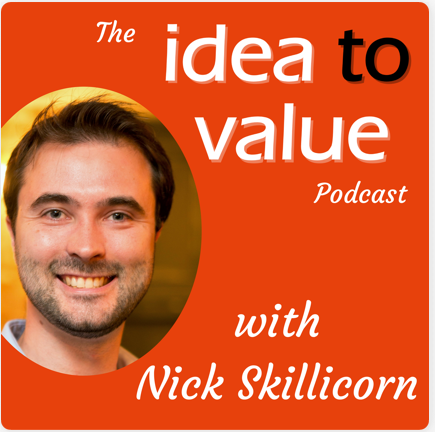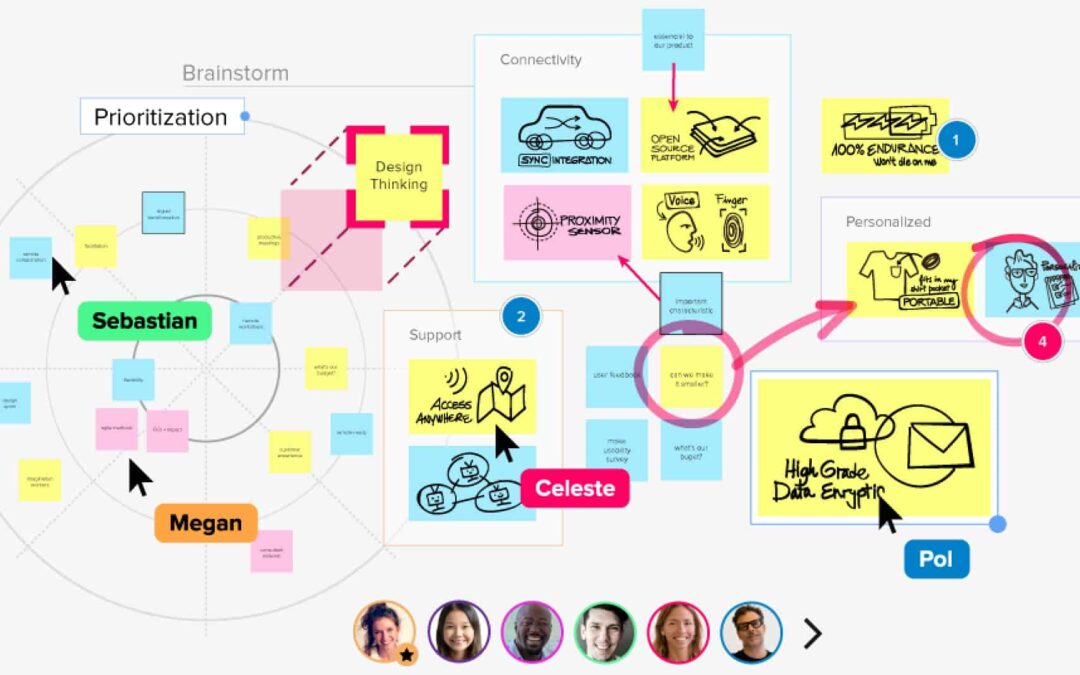


Virtual Ideation Sucks. Here’s How to Make Sure It Sucks Less.
Over the past 987,460 days of forced WFH, I’ve participated in several virtual ideations.
A few weeks ago, my turn to facilitate arrived. And, after four 4-hour sessions spread over two weeks, I can confidently declare this:
Virtual Ideation sucks.
We knew the experience wouldn’t be the same as an in-person session, so we did everything to adapt. At the end of each session, we asked participants to share their Rose/Bud/Thorn feedback. Between sessions, a smaller group met to review the feedback, reflect on our experiences, and make adjustments for the next session. We fixed 90% of the Thorns between sessions 1 and 2, and we hit our groove by session three.
But virtual Ideation still sucks.
There is simply no substitute for the energetic buzz of a room full of creators freed from the constraints of reality and excitedly imagining what could be. There is no substitute for the side conversations over caffeine and sugar where two or three innovators connect disparate dots and have an A-Ha! Moment. There is absolutely no substitute for the satisfaction that comes from stepping back and staring at a wall of ideas and the confidence that the answer is in there somewhere.
But, with Omicron and more companies realizing the hybrid work is the new reality, not a temporary stopgap, virtual ideation sessions are here to stay.
So how can we make virtual ideation sessions suck less?
Plan sprints, not marathons.
- What we did: We cut the ideation session down from the typical 8-hour day to four hours, and instead of trying to ideate on multiple topics in a single session, we had a single topic for each session. But the sessions were still too long to keep people engaged but too short to allow true reflection and building on ideas.
- What we learned: In a virtual setting,ideation sessions are a task, not an experience. Gathering people together for a day or two made lots of sense for logistical (usually held offsite, make participants less accessible to daily demands, reduce the cost of external facilitators) and experiential (enable focus, shift mindsets, get into the flow) reasons. But a virtual environment eliminates the logistical rationale for daylong sessions. It can’t deliver the experiential benefits because we can’t get away from the constant pinging of email, Slack, and text notifications.
- What we would do differently: Instead ofa four-hour session, I would do four one-hour sessions. Yes, it will take more days, but participants will be more focused on the task and more able to stay in the creative mindset (once you get them there). Plus, it has the added benefits of engaging more participants (looking at you, fellow introverts!) and giving people time to reflect and build on ideas.
Acknowledge that the practice and experience will be different
- What we did: We started the sessions by acknowledging that things would feel different, the experience would be far from seamless, and that we wanted quality over quantity. But we didn’t recognize participants’ feelings and expectations, and, as a result, the gaps between their hopes and their reality didn’t diminish.
- What we learned: Even though people know that the experience of a virtual ideation session is different from an in-person one, they still hope that it will be the same. This creates a challenge that participants will inevitably judge the experience not against their rational expectations but against their hopeful, emotional ones. And it will always come up short.
- What we would do differently: Start the session by clearly stating that the experience will be and feel different. Acknowledge that, for many, it won’t have the buzz or the rush of an in-person session. Admit that things will be more clunky because you’re relying on technology rather than your hands and feet to make things happen. Ask for their patience, support, and help to make the session and their experience of it as successful as possible. Then clearly define what success looks like.
Start with FUN!
- What we did: I hate icebreakers, “mandatory fun,” and forced group silliness. So, we didn’t do any of that in the first ideation session. Instead, we dove right into content, grounding people in the insights developed in the previous phase and introducing them to the resulting stimuli (personas, journey maps, analogies).
- What we learned: We were so task-focused that people didn’t have time to shake off their day-to-day reality, connect with the information, develop empathy for the customer, and allow themselves to be creative.
- What we did do differently: The second session started with FUN! but rather than a random icebreaker or silly exercise, we asked a question that required personal sharing and was relevant to the session’s topic. For example, if the session’s topic was “How might we create a more inspiring experience for members?” we asked participants to share their most inspiring experience.
By asking a personal question, people’s mindsets become more positive and open while they get more comfortable sharing and more curious about their fellow participants. By asking a relevant question, participants build empathy for the customer they are designing for, instantly build a library of experiences and analogies to draw from, and see possibilities beyond their day-to-day realities.
The irony of it all
What’s ironic is that, as I reflect on these lessons, they’re all things that I knew to be important, but I hadn’t yet experienced their importance.
Learn from my experience. Make these changes in your next ideation session.
What are your experiences? What have you learned? What can we learn from you?

Why You Need to Start Small to Succeed Big. Just like Picasso
On April 26, 1937, Nazi warplanes, at the request of Franco’s Spanish nationalists, bombed Guernica, a town in northern Spain’s Basque Country. Bombs rained down on the city center for two hours, killing hundreds of people, primarily women and children.
On May 1, Pablo Picasso read an eyewitness account of the bombing and immediately began sketching. Over ten days, he created more than 50 sketches – some barely more than scribbles, others with crisp and clear pencil lines forming tragic and horrifying figures, and yet others in bold hues of yellow, purple, and blue.
On May 11, Picasso stretched and prepared a canvas so massive that it could not stand upright in his studio.
In July 1937, Guernica was unveiled at the Spanish Pavilion at the Paris International Exposition. At approximately 11.5 feet tall and 25.5 feet wide, the grey, black, and white oil painting with images showing the horrors of war was met with mixed reviews.
Today, it is regarded as one of the most moving and powerful anti-war paintings ever created and hangs in a custom-built gallery at Madrid’s Museo Reina Sofia.
What does this have to do with innovation?
Look again at the timeline above. In only ten days, Picasso learned about Guernica’s bombing, was inspired to create something in response to it, drew initial sketches, and started work on the final product.
To translate this into a (somewhat poor) analogy for innovation, in only ten days, Picasso went from identifying a need (respond to the terrorist act) to brainstorming a solution (make a painting), to developing prototypes (sketches), to preparing to launch (stretching the canvas).
Ten days.
Of which almost all were spent prototyping.
How does that compare to your innovation process?
How much time do you spend identifying a need? Brainstorming solutions? Developing prototypes?
If you’re like most companies, you probably have a 10/80/10 split – 10% of your time understanding customer needs, 80% of your time in brainstorming, and 10% of your time developing and testing prototypes.
Why?
If innovation is all about solving problems and the number one reason startups and products fail is lack of product-market fit, why do you spend most of your time coming up with ideas instead of making sure they’re the right ideas?
(Don’t) Go Big or Go Home
You know that listening to your customers is crucial because they ultimately decide the fate of your innovation. You know that prototyping is essential because all ideas are initially more wrong than right.
Yet, most companies adopt a “Go Big or Go Home” philosophy. They push innovation teams to stop worrying about the “details” and “fail fast” by getting to market (and revenue) ASAP.
But this approach puts the project and the company at risk by increasing the likelihood that money, people, and reputations will be spent on projects that do not solve a pressing customer need and, as a result, fail in the market.
(Do) Go Small to Go Big
A better approach, one more likely to lead to market success, is to “Go Small to Go Big.” Instead of a 10/80/10 split, spend 40% of your time finding the problem, 10% ideating, and 50% refining your idea through prototypes.
After all, if Picasso wasn’t willing to start painting until he first did some sketches, why are you willing to spend hundreds of millions of dollars to launch something you never prototyped?

4 Storms That Accelerate Innovation (You’re Only Doing 1)
Everyone knows about brainstorms but did you know there are three other types of storms that can blow you to your innovation destination?
Questionstorms
First introduced in The Innovator’s DNA, these storms happen at the start of an innovation effort and seek to surface all the assumptions, expectations, concerns, and actual questions currently locked in individuals’ brains.
The value of this session is that it makes the implicit explicit, removes hidden agendas, eliminates guessing games, and establishes a culture of curiosity, exploration, and learning versus demands and fear.
You run Questionstorms just like brainstorms – give everyone 3-5 minutes to silently write a long list of thoughts. Then, give everyone another 3-5 minutes to turn each thought into a question and write the question on a sticky note. For example, “We need to realize $250M revenue in Year 3 to make this work” becomes “How might we design and run an innovation function that generates $250M in Year 3?” Then, each person reads their sticky notes to the group before placing them on a wall. The goal is to ask 50 questions before you start grouping and prioritizing.
Intuition-storms
I first learned about this storm from IDEO and am genuinely surprised by how effectively they re-energize teams and propel the work forward. These storms happen after the first phase of a project, usually the research phase.
An Intuition-storm’s value comes from its ability to pull the team out of the minutiae of the previous weeks and months of work and back up to seeing the big picture. In the process, they rapidly synthesize insights that may have gotten lost in the more traditional left-brained approach of gathering and summarizing details.
Again, just like brainstorms, start by posing the big question that the project intends to answer, then give people 3-5 minutes to write down their answers. Too much time and they may dig into documents and details, too little time and you’ll get recency bias in the responses. Then go around the room and share. Once everyone has shared, discuss the elements in common and the unique ones. Be clear that this isn’t about getting to THE answer, but about tapping into the full of everyone’s experience, expertise, and wisdom.
Brainstorms
By now, we all know what it means to brainstorm, and we’ve all probably been part of one or two brainstorming sessions. But do you know where it all started?
In the mid-nineteenth century, “brainstorm” was a colloquial term for “fit of acute delirious mania; sudden dethronement of reason and will under the stress of strong emotion, usually accompanied by manifestations of violence.” Not exactly the type of thing most businesspeople aim for.
However, in 1939, advertising executive Alex F. Osborn got so frustrated with his employees’ ability to generate creative ideas for ad campaigns that he developed a new approach dubbed “organized ideation.” This approach, later renamed to “brainstorm” by his employees, was governed by four rules:
- Go for quantity
- Withhold criticism
- Welcome wild ideas
- Combine and improve ideas
While the methods and tools for brainstorming have evolved over the past 80+ years, it’s a testament to Osborn’s approach that the rules have not.
Assumption-storms
Assumption-storms are rooted in the Discovery Driven Planning approach introduced by Rita Gunther-McGrath. These storms should occur as soon as you’ve picked the top 2-3 ideas from brainstorming that you want to pursue
By forcing the team to acknowledge that there are more unknowns than knowns at this point in the process and to share their assumptions and questions, Assumption-storms enable the team to quickly identify and test the most critical assumptions. This process of rapid testing of individual assumptions ensures that if a “deal-killer” assumption is wrong, the project is quickly killed and a new one started.
To Assumption-storm, gather your team around the idea(s) to be pursued and list all the things you think you know but can’t prove beyond a shadow of a doubt AND all the things you don’t know. Then rate each item (assumption) from High to Low based on how confident you are that the assumption is true and the negative impact to the idea if the assumption is wrong.
Because we all tend to be overconfident in our own knowledge, I like to base the High/Medium/Low scale for confidence based on what you would bet. High confidence means you’re willing to bet your annual salary, Medium confidence means you’ll bet your next paycheck, and no confidence means you bet a cup of tea.
Once assessed for confidence and impact, the assumptions with Low Confidence and High Impact are identified as deal-killers, and you can start to develop the experiments you’ll run to help you build confidence (or kill the idea) in the next 90-days.
Storms are a-brewin.’
And that’s a good thing. As you progress through your innovation efforts, you’ll face many storms. Some are damaging and unexpected. Luckily, these four can not only be planned, they also propel you forward.

6 Steps to Move From Chaos to Calm
“We are not lost. I know exactly where we are. Granted, it’s not where we want to be. Where we want to be is over there somewhere. I just need a moment to figure out how we get there.”
– Me to my husband every time we go to a new city and I convince him to go on a walk.
The Big Squiggly
Last week, the 13th class of Driving Intrapreneurship graduated and, as always, I was tremendously proud of the executives who, in the span of 8 short weeks, went from identifying a problem to writing an innovation business plan to secure funding and resources to continue their work.
One of the things we talk about constantly in the course is “The Big Squiggly” – a simple line drawing that starts off as a big, knotty, crumpled, chaotic mess before eventually sorting itself out and turning int a clean and simple straight line.
We spend most of the 8 weeks in The Big Squiggly and it’s even more uncomfortable and stressful than people imagine it will be when I first introduce the concept. But as the weeks go on, they get a little more comfortable and, by graduation, the mere mention of The Big Squiggly elicit knowing nods and confident smiles.
What To Do When You’re In The Big Squiggly
Innovators live in The Big Squiggly. Some of us love it there and some of us endure it because really, all we want to do, is bring order to chaos. Most of us in The Big Squiggly are like my students – uncomfortable at best and deeply stressed at worst.
In fact, being in The Big Squiggly can feel like being in the middle of a crisis.
Interestingly, they way innovators work through The Big Squiggly is very very similar to how leaders are taught to manage crises. Here is the 6-step approach that Harvard Professor Dutch Leonard teaches in his Crisis Management for Leaders course:
- Establish a team and process to identify, understand, and reframe issues
- Assemble a team with diverse perspectives
- Engage in iterative, agile problem-solving
- Create conditions (facilitated deliberation, diversity, psychological safety, inquiry not advocacy) for successful agile problem-solving
- Execute chosen actions but treat them as tentative and experimental
- Set reasonable expectations that you are making your best effort, learning rapidly, not everything will work, and we’ll keep working until it does
Hmmmmm, sounds exactly like how innovation works, too.
We’re all in The Big Squiggly Together
Everyone is innovating right now. From big companies responding to the Great Resignation and supply chain disruptions, to individuals trying to figure out whether and when to work form home or the office . We’re all doing something different, hoping it creates value, and pivoting until it does.
Yes, we are being forced to innovate and, like all innovation efforts, we’re not getting everything perfect but we’re learning a heck of a lot. Just imagine what we could do if we keep innovating when the crisis ends. Imagine the problems we could solve and the things we could create if we choose to continue to listen, learn, and experiment!
My friend, Dr. Anne Waple, has been a climate scientist for over 25 years. About a year ago, she spoke at Speakers Who Dare about her vision for Earth’s Next Chapter. Even in the early days of America’s response to COVID-19, Anne encouraged people to not just focus on problems because, when we do that, we don’t actually solve them. Instead, she asserted, driving positive, big, lasting global change starts when we ask questions about the world we want and believe we can have fun making it happen.
Together, We Can Get Out of The Big Squiggly
We are not lost. We’re just not where we want to be right now.
Yes, The Big Squiggly is uncomfortable and stressful. But it’s not forever. By asking questions about the world we want, we can define “over there somewhere.” How we get there is through innovation and we know and are already practicing the steps.